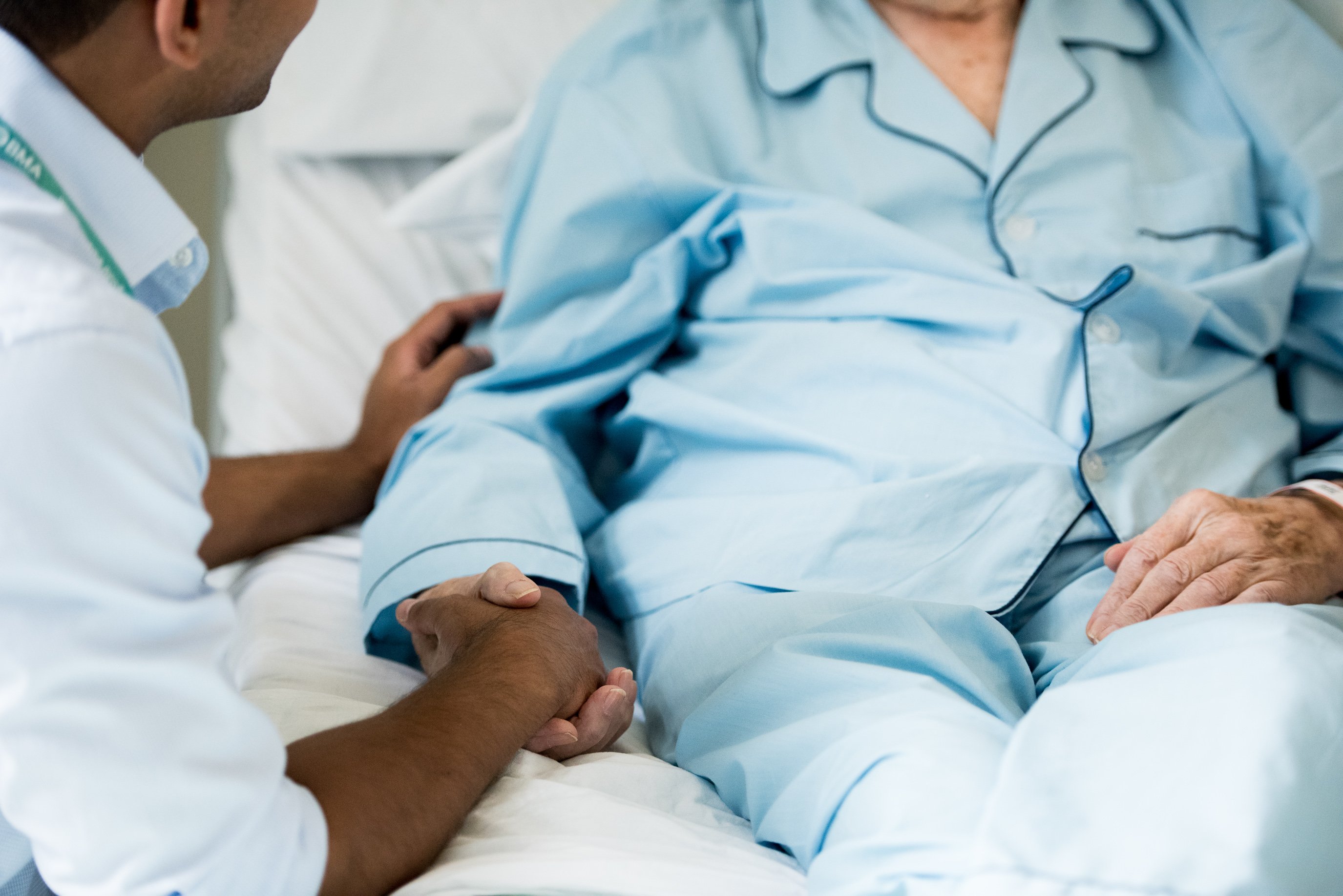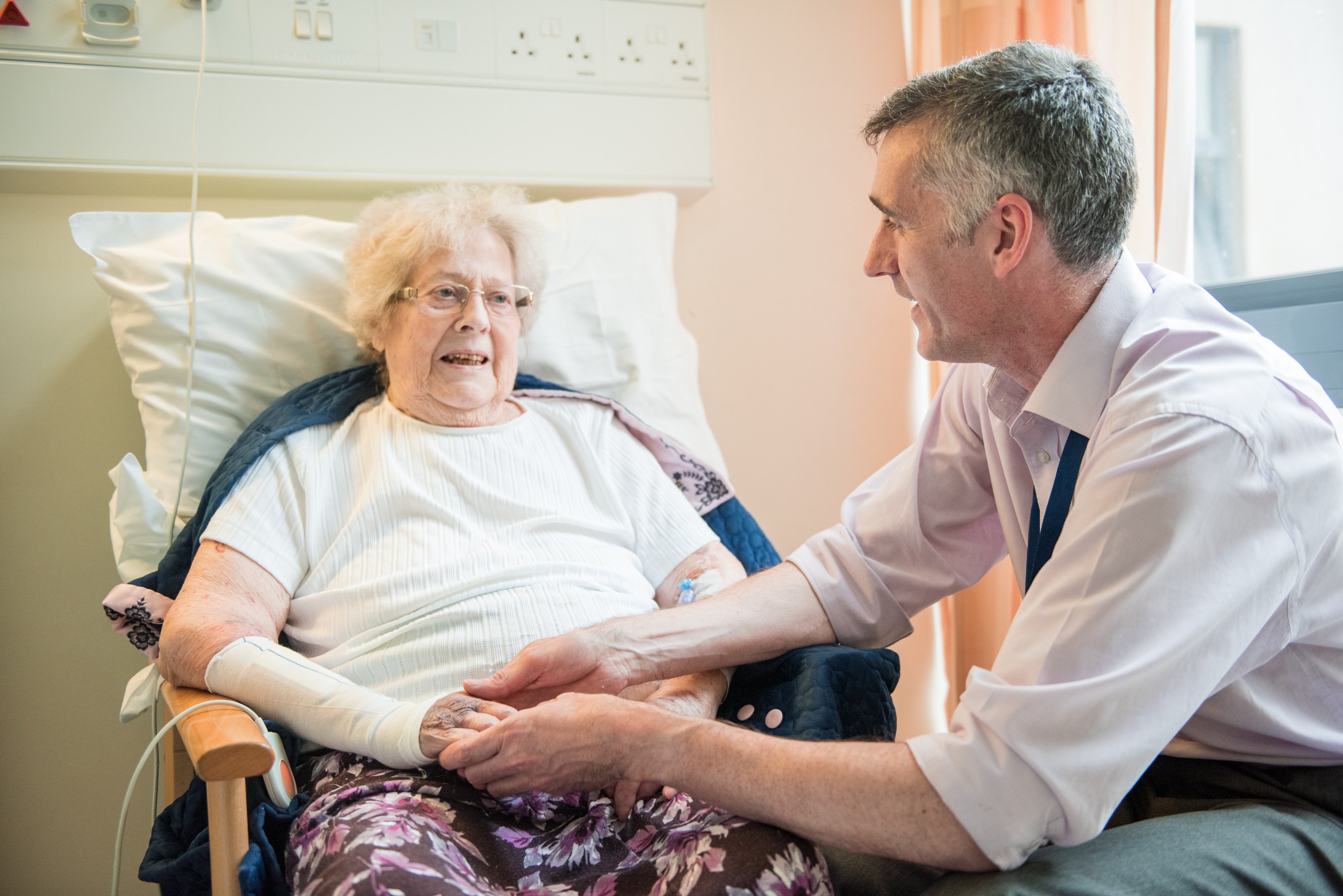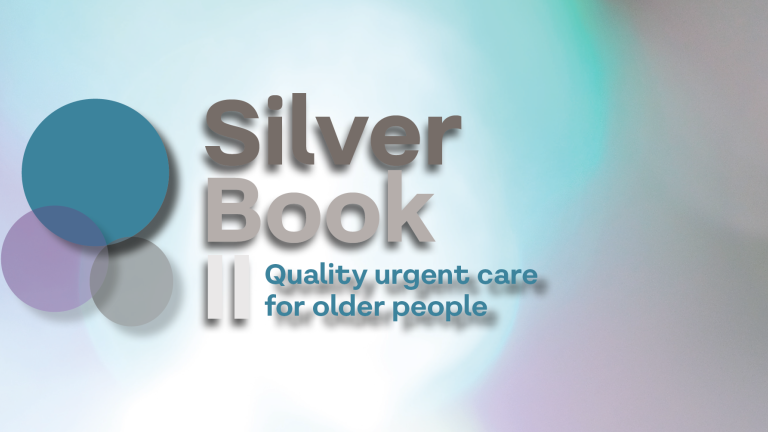Silver Book II: Training and development
General skills and competencies for all care providers
Care of the acutely ill or injured older person takes place over a wide spectrum of settings from in-home community-based care, to in-hospital acute or intensive care, and back.
In some cases, gaining competency will require general enhancements of pre-employment training and education. However, competency will more likely be achieved through additional field-based, ‘real-life’ on-the-job training. Ultimately every provider continually refines their knowledge and skills to reach expertise, the ability to provide care at the time and in the place where it offers the best care option available for each patient.
It is a common observation that, in most health care education systems, there is little focused education in the specific skills needed to assess, treat, and work with older people. Although older people often make up the bulk of patients seen by health care workers, education in many international systems, treats older people as though they were exceptions or outliers to usual care. It is critical to educate students, trainees, and workers about both general and specific skills needed in older adult care. This chapter will guide educational enhancements to close that competency gap.
To develop competency, it is necessary to develop across three domains – skills, knowledge, and attitudes.
Skills: ‘Hard’ skills which require the appropriate completion of a physical task (e.g. how to transfer a person from wheelchair to bed, how to perform an ultrasound-guided femoral nerve block); and ‘soft’ skills such as facial expressions and touch and body posture (e.g. how non-verbal cues can help to gather information from a person with hearing or cognitive impairment).
Knowledge: This relates to knowing a fact and how to interpret it (e.g. what the normal blood pressure range is for older patients and what it means when abnormal; or the right height for a walker and how to fit one; or what indications for transfer to a higher level of care may be). Other areas of knowledge enhancement include a familiarity with the ways in which older people are different from the general population whether socially, functionally, physiologically, or anatomically. Competent providers have an awareness of community services and resources that others can provide, which may benefit the older person. Additionally all must develop clinical reasoning and assessment skills which might be as basic as identifying when someone ’just isn’t right’.
Attitudes: This relates to feelings or emotions and opinion development, such as changing the way you think or feel about care of older persons resulting in a more positive behaviour. This attitude would manifest as a willingness to spend more time; or an openness to collaborate more intensively with family members or interdisciplinary colleagues. It is the perspective that an older person is an intrinsically valuable and important member of society. Maintaining a positive attitude that one’s own actions, however minimal, have the potential to improve the older person’s life. Excellent providers identify and avoid ageist attitudes which devalue, categorise, or dismiss older people and their issues.
These issues of skills, knowledge, and attitude development exist for all providers across the entire spectrum of care provision for an ill or injured older person, from personal support workers to geriatricians; from doctor’s offices to intensive care units.260
Communication skills
Probably the greatest area of skills enhancement specific to care of older people is communication.
Effective communication skills (the ability to clearly and consistently communicate empathy, compassion, respect, patience and build rapport with patients, families, and caregivers) is another skill set essential at every point along the care continuum.
Communication with older people
(Please click the '+' icons below to expand the tables).
Communication with older people
(Please click the '+' icons below to expand the tables).
Australian resources
|
Australian Information |
||
|
Website name |
URL |
Description |
|
National Ageing Research Institute -training notes for communication |
Strategies to enhance staff-resident communication in residential aged care |
|
|
Ausmed Education |
Communicating with older patients |
|
|
Relationships Victoria |
General communication tips with downloadable Good Communication Card and Video |
|
|
State Government of Victoria, Australia – Health Victoria |
Communicating with older people who have diverse needs |
|
|
Mental Health First Aid |
https://mhfa.com.au/sites/default/files/MHFA-helping-the-confused-older-person.pdf |
Guidelines for helping the confused older person with dementia |
United States resources
|
United States Information |
||
|
Arizona Center on Aging: Elder Care - A Resource For Interprofessional Providers |
http://aging.arizona.edu/program/elder-care-resource-interprofessional-… |
Elder Care Provider Fact Sheets and Care Partner Information Sheets are available in PDF format. Includes a section on Communication |
|
Geriatric Fast Facts |
Quick answer/fact sheets on various topics, including family meetings |
|
|
The Gerontological Society of America |
Video on general provider communication and attitudes |
|
|
National Institute on Aging: Talking with your older patient |
https://www.nia.nih.gov/health/publication/talking-your-older-patient |
Links to PDF chapters of the Handbook, Talking with your older patient |
|
Gerontological Society of America: Communicating with Older Adults
|
https://www.geron.org/publications/communicating-with-older-adults |
Two relevant publications available for free download |
|
GeroNet UCLA David Geffen School of Medicine |
http://www.geronet.med.ucla.edu/professionals/patient-care-resources |
List of national resources and national disease resources. Not perfect because others are CA specific. |
|
GeriPal A Geriatrics and Palliative Care Blog |
https://www.geripal.org/2012/08/oncotalk-legacy-intensivetalk-and.html |
Of general interest |
|
Centers for Disease Control and Prevention: Alzheimer’s Disease and Healthy Aging |
Health Literacy tools specific to older adults, links to US state and local agencies, and CDC reports |
|
|
National Council on Aging: Resources for Professional |
https://www.ncoa.org/audience/professional-resources/?post_type=ncoares… |
Up to date topic and webinar links and Searchable database of their publications |
Additional training and development of staff in working with older people
The training of staff who participate in the care of older people during an episode of acute injury or illness is essential for safe and effective care delivery. This is not restricted to medical practitioners but is required across the spectrum. This section explores specific skills relevant to care providers from several specific disciplines.
Medical staff
Considerable work has gone into establishing the Geriatric Competencies in Emergency Medicine. These are specific competencies required by emergency physicians to provide excellent care to older patients. These competencies define the eight highest yield areas where knowledge will most likely impact quality of care provided, for example atypical presentations. Older patients with myocardial infarction (MI) present in a fairly consistent fashion that should be known. The average 80-year-old with MI does not have chest pain, but the primary symptom is usually dyspnoea. The term 'atypical' assumes the bias that practitioners only know the symptoms typical in younger persons. However, each disease/illness presents just as ‘typically‘ or consistently among older persons. Medical staff simply need to learn the differences.
The competencies are grouped within the following domains:
- Atypical presentations - These recognise the specific way older people manifest illness and injury are different from (or atypical from) those of younger people (see section on Non-Specific Presentations).
- Trauma and falls – These are very different in older people (see sections on Falls and Syncope and Silver Trauma).
- Cognitive impairment - Both dementia and delirium are critical aspects of older people's care (see sections on Dementia and Delirium).
- Emergency care modifications - ‘Usual‘ emergency care changes to be age- and person-appropriate.
- Medication and pain management – Older adult care considers medications in the presence of polypharmacy, comorbidity, and aging physiology (see section on Pain).
- Transitions of care – Must be managed differently as older patients move through the care system (see section on Transitional Care).
- End of life - Issues such as establishing goals of care, symptom management, and arranging access to palliative care resources (see section on End of Life Care).
- Comorbidities – Older adult care requires managing multiple active medical conditions as they impact one another.
Other geriatric educational resources for emergency physicians are available at:
- GeriatricsCareOnline.org - The Geriatrics for Specialty Residents Toolkit: Emergency Medicine
- European Society for Emergency Medicine (EuSEM) - The Development of a European Curriculum for Geriatric Emergency Medicine
These geriatric domains apply equally well to most physicians and surgeons providing care to an ill or injured older person in hospital. In fact, these competency domains could also provide guidance to any clinician – nurse, physiotherapist, occupational therapist, paramedic, etc. – who wanted to supplement their clinical competency set. Each of these domains probably requires additional education beyond what is currently offered in undergraduate medical or specialty level education; whether this can best be supplemented by off-service geriatric medicine exposures or focussed training on the job will be situation-dependent.
To improve care of older adults in the US by increasing specialty physicians’ competence in geriatrics, the Geriatrics for Specialists Initiative created content to increase competency from the ED through post-operative care. This includes: anaesthesiology, emergency medicine, general surgery, gynaecology, ophthalmology, orthopaedics, otolaryngology, physical medicine and rehabilitation, urology, trauma surgery, thoracic surgery, and vascular surgery. The Geriatrics Competencies by Specialty can be found here, and Geriatrics for Specialty Residents educational toolkits are available here. Many physician training programmes have introduced curricula that cover the geriatric competencies specifically.
|
Resources: Medical Staff
|
Nursing staff
- The Emergency Nurses Association (ENA), provides educational resources for Older Adults in the Emergency Setting such as topic briefs from triage to discharge. These include screening tools to help nurses assess the physical, social and emotional needs, and a position statement which addresses safe discharge from the emergency department. ENA also offers a comprehensive course in Geriatric Emergency Nursing Education.
- The American Association of Colleges of Nurses has identified Gerontology Acute and Primary Care competencies for Nurse Practitioners and competencies for nurses at the baccalaureate level.
- The Gerontological Advance Practice Nurse Association has educational resources for Emergency Nurses and Advanced Practice Nurses and offers a Gerontological Specialist Exam.
- The Hartford Institute for Geriatric Nursing has the How to Try This® series with articles and videos on a variety of older adult care topics, divided into general, specialty practice, and dementia series.
- The Royal College of Nursing Emergency Care Association has an Older People’s Forum with topic pages on dementia, home care, delirium, falls, frailty, and support of healthy aging.
- The College of Emergency Nursing provides guides for the Geri-Friendly ED and the nursing-led Aged Care Emergency (ACE) model of care (use 'age' as username and 'care' as password to log in, access details shared with permission).
Phyiotherapists
- Increase, restore or maintain range of motion, physical strength, flexibility, coordination, balance and endurance
- Prevent further decline in functional abilities through education, energy conservation techniques, joint protection
- Teach positioning, transfers, and walking skills to promote maximum function and independence within the person's capability
- Improve sensation and joint proprioception
- Manage or reduce pain
- Increase overall fitness through exercise programs.
Occupational therapists
|
Resources: Occupational therapists
|
Paramedics and pre-hospital care
|
Resources: Paramedics |
Community paramedicine
Community paramedicine (CP), also known as Mobile Integrated Healthcare, provides opportunities to tailor care for older adults and to offer proactive preventative care prior to a health crisis or better-integrated acute care services. CP is a term used to describe expanded paramedic scope and practice in non-traditional roles where paramedics are viewed as physician extenders,267 recognising that non-physician clinicians are under-used.268 This has meant a shift towards developing models of care that are often ‘care in place’ or referral to another health care service other than the ED. Most CP programs target vulnerable populations such as older adults in social housing269, long-term care,270 or older adults with acute exacerbations of chronic conditions.267 Community paramedic pathways provide treat-in-place, treat-and-refer, or traditional transport to urgent care options that are adjuncts to existing health care services. Community paramedics routinely conduct multi-domain assessments which provide rich information that can inform care planning and goal setting.271
|
Resources: Paramedicine |
Long-term residential care
- Leadership support for improving care when a change in condition happens is essential
- Designate a ‘champion’ on the staff to promote new practices and sustain focused attention on the improvement effort
- Train all staff in the nursing home on how to recognise signs and symptoms that signal a potential change in resident status
- Formalise reporting pathways so that all staff know when and to whom to report a change
- Develop a standard approach or workflow for how a change in status will be evaluated
- Train all clinical staff on this workflow, particularly staff that are responsible for telephonic coverage during the evening/night/weekend hours
- When a hospital transfer is necessary, use a standard communication template and have a nurse-nurse or doctor-doctor phone conversation to ensure shared understanding of the reason for transfer and goals of care (see INTERACT transfer document as one example of a useful resource).
|
Resources: Long term residential care
|
Home-based acute care
- Recovery from an illness or injury, regaining or maintaining independence, managing chronic conditions, or medication management
- Specialised nursing care in skin and wound care, diabetes, continence, dementia, mental health and palliative care
- Mobility and rehabilitation
- Post-hospital care
- End-of-life care at home
- Domestic tasks, such as cleaning, laundry and meal preparation
- Personal care such as bathing and dressing
- Gardening and home maintenance
- Transport for appointments and shopping
- Companionship and social support
- Ability to work autonomously
- Clinical reasoning and holistic assessment skills to identify common conditions, such as delirium, dementia, malnutrition, mental health issues
- Risk assessment and management skills
- Knowing when to refer to other health professionals
- Recognition and management of early changes and potential clinical deterioration.
| Functional or sensory decline |
| Change/alteration in skin integrity |
| Reduced oral intake |
| Loss of appetite or unplanned weight loss/gain |
| Altered blood glucose levels |
| Altered vital signs |
| Wound deterioration/failure to progress |
| Change in urine output or change in bowel habits |
| Altered cognition or changes in communication |
| Changes in mental health |
- Skills with enabling and/or supporting an individual’s activities of daily living (ADL) such as eating and drinking, bathing, toileting, skin care, oral hygiene
- Assisting with domestic ADLs such as light housekeeping activities
- Assistance with medication support, in accordance with established employer or government policy and scope of practice
- Companionship and social support
- Observation skills to recognise, document and communicate changes in physical or cognitive function.
|
Resources: Home based acute care
|
Social support
Social work
Social Workers can be most helpful in managing deteriorating cognition and mental health, inadequate housing, maltreatment neglect and abuse, advance directives, and managing the economics of individual/group benefits and insurance eligibility. They are sometimes responsible for arranging post-acute care placements. Challenges that face Social Workers include both training and staffing of services, which have not kept pace with the increased demands of aging population.273 Social Workers can support patients and families to adapt to evolving roles and responsibilities, particularly during an episode of acute illness or injury.274
|
Resources: Social work |
Case management
Areas in which case management can be most helpful include arranging and providing in-home nursing service, medication arrangement and monitoring, maintaining mobility, wound care support, arranging durable medical equipment, and providing bedside care.
Case Managers can be involved with arranging post-acute home services including home nursing, IV infusion management, medication management, durable medical equipment, and physical/occupational therapy. Specific skills required to provide in home Case Management include making initial health evaluations, cleaning and dressing wounds, monitoring vital signs, and supervision of home care workers.
|
Resources: Home case management |
Essential social care skills and competencies
Social Workers, and Case Managers must maintain the perspective that they are also navigating multiple systems. Integrating these systems in an essential component of successful treatment. Patients operate within their family system, community system, and larger cultural system. The expectations on family to manage home care is increasing as longevity increases.273 Beyond the family system, integration of community systems is important to longer term planning.273 Community and cultural system integration allow resources to operate within and beyond certain aspects of the acute hospital stay.
|
Resources: Social workers and case managers
|


